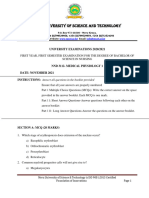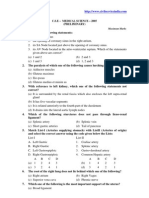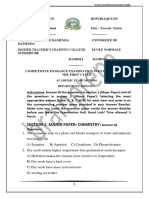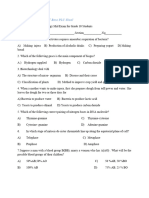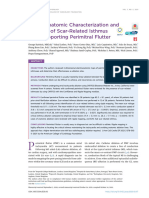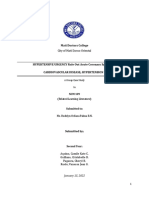0 ratings0% found this document useful (0 votes)
19 viewsCCM 3123 Human Physiology I
CCM 3123 Human Physiology I
Uploaded by
y mugambiCopyright:
© All Rights Reserved
Available Formats
Download as PDF, TXT or read online from Scribd
CCM 3123 Human Physiology I
CCM 3123 Human Physiology I
Uploaded by
y mugambi0 ratings0% found this document useful (0 votes)
19 views11 pagesOriginal Title
Ccm 3123 Human Physiology i
Copyright
© © All Rights Reserved
Available Formats
PDF, TXT or read online from Scribd
Share this document
Did you find this document useful?
Is this content inappropriate?
Copyright:
© All Rights Reserved
Available Formats
Download as PDF, TXT or read online from Scribd
Download as pdf or txt
0 ratings0% found this document useful (0 votes)
19 views11 pagesCCM 3123 Human Physiology I
CCM 3123 Human Physiology I
Uploaded by
y mugambiCopyright:
© All Rights Reserved
Available Formats
Download as PDF, TXT or read online from Scribd
Download as pdf or txt
You are on page 1of 11
MERU UNIVERSITY OF SCIENCE AND TECHNOLOGY
P.O. Box 972-60200 – Meru-Kenya.
Tel: +254 (0) 799 529 958, +254 (0) 799 529 959, +254 (0) 712 524 293
Website: www.must.ac.ke Email: info@must.ac.ke
University Examinations 2019/2020
FIRST YEAR, SECOND SEMESTER SPECIAL / SUPPLEMENTARY EXAMINATION FOR
BACHELOR OF SCIENCE IN CLINICAL MEDICINE AND COMMUNITY HEALTH
CCM 3123: HUMAN PHYSIOLOGY I
DATE: NOVEMBER 2020 TIME: 3 HOURS
INSTRUCTIONS:
This examination consists of Three sections
Section One: Multiple Choice Questions
Each question consists of a common stem that gives rise to four responses (A-D). In every
question identify THE MOST CORRECT (BEST RESPONSE) answer.
Section Two: Short Answer Essay Questions
Section Three: Long Answer Essay Questions
All questions are compulsory.
SECTION ONE: MULTIPLE CHOICE QUESTIONS INDICATE TRUE OR FALSE
FOR ALL RESPONSES. (50 MARKS)
1. Which of the following catalyzes the cutting of P1P2 into 2 moles of IP3 and
diacylgylcerol in cell signaling?
a) Phosphokinase C.
b) Phospholipase C.
c) Lipokinase C.
d) Phosphodiesterase C
Page 1
2. The common progenitor cell for granulocytes and monocytes is
a) GM-CSF
b) Eo-CSF
c) GM-CFC
d) G-CSF
3. An ideal semi-permeable membrane
a) Is permeable to water only
b) Is permeable to water and solutes
c) The cell membrane is a prototype because it is impermeable to crystalloids
d) Is porous
4. Which is not physiological
a) Salivating at the smell of food
b) Palpitations at the sight of a snake
c) Hyperventilating while resting
d) Increased insulin production after a starch meal
5. Which is not a characteristic of a living being
a) Transduction of energy for metabolism
b) Eukaryotic cellular organization
c) Genetic inheritance
d) Dormant to noxious stimuli
6. which is not a function of the integumentary system
a) Perception of stimuli
b) Thermoregulation
c) First line of body defense
d) Endocrine function
7. In the homeostatic control of insulin secretion
a) The effect of the response is to increase blood sugar level
b) The effecter is the beta cells of the islet of Langerhan
c) The sensors are mechanoreceptors
d) None of the above
8. Organ systems:
Page 2
a) Perform only one function
b) The brain is an example
c) May have several organs involved
d) All the above are correct
9. Functions of blood include the following except:
a) Excretory functions
b) Role in defense mechanisms in the body
c) Nutrients detoxification
d) Transportation of various substances around the body
10. Net movement of substances from an area of high concentration to low concentration is?
a) Active transport
b) Facilitated diffusion
c) Osmosis
d) Simple diffusion
11. The second messenger responsible for release of calcium from endoplasmic reticulum is:
a) Inositol triphosphate (IP3)
b) Diacylgylcerol (DAG)
c) Protein kinase A (PKA)
d) Cyclic adenosine monophosphate (cAMP)
12. Fluid in this compartment is not categorized as transcellular fluid. Which one?
a) Peritoneal
b) Plasma
c) Cerebrospinal fluid
d) Intraocular
13. A cell placed in a hypertonic solution will be?
a) Lysed
b) Flaccid
c) Turgid
d) Shriveled
14. Which one is incorrect about DNA structure?
a) It is a type of nucleic acid
Page 3
b) It is a type of organic compound
c) It is not a polymer
d) It directs protein synthesis
15. Which one is false concerning golgi apparatus?
a) Repackaging, modification and storage of proteins
b) Formation of lysosomes
c) Manufacturing of glycoproteins
d) Degradation of foreign bodies
16. The respiratory system serves many functions in the human body. These include
respiration, olfaction and?
a) Impulse integration
b) Lactation
c) Phonation
d) Detoxification
17. The functions of cell membrane include all of the following except?
a) Structural integrity
b) Protein synthesis
c) Protection
d) Conduit for ions
18. Which statement is not correct about genes?
a) Genes code for a protein
b) Genes are long strands of DNA on chromosomes
c) Genes coding for similar proteins are located at different gene loci
d) Genes are hereditary
19. The following is not a structural component of the nucleus
a) Lipid monolayer membrane
b) Chromatin
c) Nucleolus
d) Nuclear pore
20. Which of the following is usually the dominant pacemaker and fires the fastest?
a) SA node
Page 4
b) AV node
c) His bundle
d) Purkinje fibers
21. Which of the following is NOT a part of the specialized conduction system of the heart?
a) Cells of the SA node
b) Cells of the AV node
c) Working myocardial cells
d) His bundle
22. Which of the following vessels has the largest effect on total peripheral resistance?
a) Arteries
b) Arterioles
c) Veins
d) Venules
23. Which of the following blood vessels has the greatest compliance?
a) Arteries
b) Veins
c) Arterioles
d) Capillaries
24. Which of the following will NOT increase aortic systolic blood pressure?
a) Decrease in arterial compliance
b) Decrease in aortic distensibility
c) Increase in stroke volume
d) Decrease in ejection velocity
25. If a patient is suffering from swollen hands, feet and face, all of the following could be a
cause, except?
a) Large decrease in arterial blood pressure
b) Lymphatic blockage
c) A decrease in plasma proteins
d) Increase in capillary permeability to proteins
26. CO2 is primarily transported in arterial blood as
a) Carboxyhaemoglobin
Page 5
b) Carbonic acid
c) Carbamino-hemoglobin
d) Bicarbonate
27. Which of the following is a CORRECT order of blood flow through the heart?
1. Right atrium
2. Left atrium
3. Right ventricle
4. Left ventricle
5. Vena cava
6. Pulmonary artery
7. Pulmonary vein
8. Tricuspid AV valve
9. Bicuspid (mitral) AV valve
10. Pulmonary valve
11. Aortic valve
12. Aorta
a. 5,1,9,3,10,6,7,2,8,4,11,12
b. 5,1,8,3,10,7,6,2,9,4,11,12
c. 5,1,8,3,10,6,7,2,9,4,11,12
d. 5,1,8,3,11,6,7,2,9,4,10,12
28. Lymph flow from the foot is
a) Increased when an individual rises from the supine to standing position
b) Increased by massaging the foot
c) Increased when capillary permeability is decreased
d) Decreased by exercise
29. Which of the following statements concerning the normal heart sounds is true?
a) The first heart sound corresponds with the closure of the mitral and tricuspid
valves.
b) The first heart sound occurs just before the R wave of the ECG
c) The first heart sound is split into two components during inspiration
d) The second heart sound occurs during the T-wave
Page 6
30. The aortic valve
a) Prevents the backflow of blood into aorta during ventricular diastole
b) Prevents the backflow of blood into the left ventricular diastole
c) Prevents the backflow of blood into the left ventricle during ventricular
systole
d) Prevents the backflow of blood into the aorta during ventricular systole
31. Which of the following indicates the causes of the first and second heart sound in the
correct order?
a) Atrial systole – ventricular systole
b) Semilunar valve closure – atrioventricular valve closure
c) Ventricular diastole – semilunar valve closure
d) Ventricular systole – ventricular diastole
32. Which of the following is the first branching of the brochial tree that has gas exchanging
capabilities?
a) Terminal bronchioles
b) Respiratory bronchioles
c) Alveoli
d) Alveolar ducts
33. An ECG report should contain:
a) Rhythm
b) Conduction intervals
c) A description of the QRS complexes, ST segments, T-waves
d) All of the above
34. Ventricular muscle depolarization is represented by:
a) P wave
b) T wave
c) The QRS complex
d) U wave
35. P wave represents:
a) Depolarization of right ventricle
b) Depolarization of both atria
Page 7
c) Depolarization of left ventricle
d) Atria to ventricular conduction time
36. The rate of diffusion of gases across the respiratory membrane is inversely proportional
to
a) Pressure gradient across the respiratory membrane
b) Surface area of the respiratory membrane
c) Solubility of the gas
d) Thickness of the respiratory membrane
37. Type II alveolar pneumocytes
a) Develop from type I pneumocytes
b) Secrete surfactant
c) Are macrophages
d) Form the primary lining cells of the alveolar epithelium
38. Concerning Stroke Volume, End Systolic Volume means?
a) Amount of blood remaining in a ventricle after contraction
b) Volume of blood pumped by a ventricle per beat
c) Amount of blood in a ventricle at end of diastole
d) Percentage of end diastolic volume that is pumped by the ventricle
39. Gaseous exchange between the lung alveoli and the blood of the pulmonary circulation
depends on all except?
a) Gas partial pressure differences
b) The amount of cilia on the inner lining of the alveoli
c) The integrity of lung membranes
d) Blood flow in and out of the lungs
40. Cardiorepiratory adaptation during training includes all except?
a) Increase in heart mass and LV volume
b) Increase in HR with age
c) Increase in TV and lung perfusion
d) Increase in O2 extraction due to increased oxidative capacity
41. During inhalation?
a) The diaphragm and intercostals muscles relax
Page 8
b) The diaphragm and intercostals muscles contract
c) The diaphragm domes upwards
d) The lung volume decreases
42. Endoplasmic Reticulum
a) Granular endoplasmic reticulum is responsible for synthesis of lipid
substances
b) Main function of endoplasmic reticulum is to synthesize new protein
molecules in the cells.
c) Agranular endoplasmic reticulum is attached to many ribosomes for synthesis
of protein molecules.
d) All parts of endoplasmic reticulum is lined with rough granules
43. In eukaryotic cells:
a) Cytoskeleton determines the shape and size of the cell
b) The cytoskeleton is not attached to the organelles and proteins
c) Cell to cell recognition is not a function of the plasma membrane
d) Carrying of genetic material is not a function of the nucleus.
44. During forced inspiration, this muscle spreads the ribs apart, thus increasing thoracic
volume. Which one?
a) Scalenes
b) External intercostals
c) Internal intercostals
d) Abdominal obliques
45. One of the following is not a component of connective tissue. Which one?
a) Matrix
b) Cells
c) Fibers
d) Neurons
46. Which of the following vessels has the largest effect on total peripheral resistance?
a) Arteries
b) Arterioles
c) Veins
Page 9
d) Venules
47. Which one correctly depicts the hierarchical organization of life?
a) Organisms-species-population-ecosytem-biosphere
b) Organisms- population-ecosystem-species-biosphere
c) Organisms-species-ecosystem-population-biosphere
48. All of the following are types of T-lymphocytes except?
a) Helper
b) Plasma
c) Suppressor
d) Memory
49. One of the following is not a function of the integumentary system
a) Perception of pain
b) First line body defense
c) Synthesis of cholecalciferol
d) Excretion
50. Membranes are physical barriers that form part of structural components of cells. Which
one of the following is TRUE concerning membranes?
a) An ideal semi-permeable membrane is permeable to water and impermeable
to solutes
b) A permeable membrane allows passage of solutes but bars the solvent
c) An ideal semi-permeable membrane is permeable to solutes but impermeable
to water
d) A permeable membrane allows passage of solvent but bars the solutes
SECTION TWO: SHORT ANSWER QUESTIONS (60 MARKS)
1. Describe five roles of the epithelia tissue (5 marks)
2. Describe how the secretion of oxytocin is regulated through homeostatic control systems.
(5 marks)
3. Discuss five characteristics of life (5 marks)
4. List four types of plasma proteins and state the functions of globulins. (5 marks)
5. a) What is endocytosis? (2 marks)
b) Identify and briefly describe the types of endocytosis. (3 marks)
Page 10
6. Explain five mechanisms through which the integumentary system conserves body heat.
(5 marks)
7. Briefly discuss the structure of a nucleus. (5 marks)
8. Describe the composition and function of plasma. (5 marks)
9. a) List three ions found in the extracellular fluid space. (3 marks)
b) State two examples of trancellular fluid (2 marks)
10. Outline the functions of the epidermis. (5 marks)
11. List the factors affecting cardiac output and the effect of each. (5 marks)
12. Briefly describe the forces involved in tissue fluid (interstitial fluid) formation (5 marks)
SECTION THREE: LONG ANSWER QUESTIONS. (40 MARKS)
1. Discuss the chemical control of respiration (10 marks)
2. Discuss the functions of blood as a tissue (12 marks)
3. Discuss the homeostatic mechanisms of thermoregulation by the skin. (10 marks)
4. Explain the physiological basis of the heart sounds. (8 marks)
Page 11
You might also like
- IBHRE QuizzesDocument105 pagesIBHRE QuizzesAnonymous hF5zAdvwCC95% (22)
- Human Biology PASS Mid-Tri Exam Buster 2021Document12 pagesHuman Biology PASS Mid-Tri Exam Buster 2021Robert100% (1)
- 0653 Combined ScienceDocument131 pages0653 Combined ScienceGodfrey RugareNo ratings yet
- BIO271 - Practice MCQDocument6 pagesBIO271 - Practice MCQEric LuongNo ratings yet
- Physiology MCQsDocument26 pagesPhysiology MCQskebkebz100% (18)
- Nnu 3112 Medical Physiology I 1Document6 pagesNnu 3112 Medical Physiology I 1bosco kiuriaNo ratings yet
- Bms1021 Pass MCQ RevisionDocument8 pagesBms1021 Pass MCQ RevisionPooja Gupta100% (1)
- C.S.E - Medical Science - 2005 (Preliminary) : Time Allowed: 2 Hours Maximum MarksDocument17 pagesC.S.E - Medical Science - 2005 (Preliminary) : Time Allowed: 2 Hours Maximum MarksAV LucentNo ratings yet
- Class XI Bio SET - BDocument3 pagesClass XI Bio SET - BRudranshi MajhiNo ratings yet
- physiology-mcqDocument10 pagesphysiology-mcqKkrish KatijaNo ratings yet
- 11th Zoology EM Half Yearly Exam 2023 Question Paper Pudhukottai District English Medium PDF DownloadDocument2 pages11th Zoology EM Half Yearly Exam 2023 Question Paper Pudhukottai District English Medium PDF Downloadgokulkumarsaravanan9393100% (1)
- Human Anatomy Mid Sem 2012Document14 pagesHuman Anatomy Mid Sem 2012Jacob Tuna NguyenNo ratings yet
- FMDC Past Paper PakLearningSpotDocument17 pagesFMDC Past Paper PakLearningSpotMuneeb UlHasaanNo ratings yet
- MCQ 50Document11 pagesMCQ 50sakar_bajNo ratings yet
- TEAS Science Part IIIDocument16 pagesTEAS Science Part IIIJohnNo ratings yet
- TEAS 7 Assessment Sci TestDocument23 pagesTEAS 7 Assessment Sci Testjosephinetwine1100% (3)
- MDTP24Document8 pagesMDTP24KB InformationNo ratings yet
- Test 5 Key ADocument8 pagesTest 5 Key Athu_vu_29No ratings yet
- Pp2004 - Aipg - MdsDocument36 pagesPp2004 - Aipg - MdsRiha KaseraNo ratings yet
- Model Exam - English - CopieDocument8 pagesModel Exam - English - CopieismailNo ratings yet
- اسئلة امتحان الفسيو السنين السابقهDocument30 pagesاسئلة امتحان الفسيو السنين السابقهwww.mohammed2004sweisyNo ratings yet
- NND 3112 Medical Physiology IDocument6 pagesNND 3112 Medical Physiology Iadeliarabuogi2024No ratings yet
- Lecture 13-14 Animal Physiology - QuestionsDocument6 pagesLecture 13-14 Animal Physiology - QuestionsGucci GengNo ratings yet
- Expected General Science (Biology) Questions (MCQS) For SSC, Railway and Upsc ExamsDocument23 pagesExpected General Science (Biology) Questions (MCQS) For SSC, Railway and Upsc ExamsAnshu YadavNo ratings yet
- Half Yearly class 11Document5 pagesHalf Yearly class 11UJNo ratings yet
- CVS End Round-1Document27 pagesCVS End Round-1nadakattan2004No ratings yet
- 1st Test Bio (2) Sample2Document6 pages1st Test Bio (2) Sample2eman abdulghanyNo ratings yet
- APIIPractice QuestionsDocument18 pagesAPIIPractice QuestionsamandaNo ratings yet
- Medical Science Objective Questions Part 1Document17 pagesMedical Science Objective Questions Part 1John Ogwu IkwuobeNo ratings yet
- Test 9 BDSDocument11 pagesTest 9 BDSrababNo ratings yet
- Section 1: Major Paper: Chemistry:: ACADEMIC YEAR: 2015/2016 Department: BiologyDocument8 pagesSection 1: Major Paper: Chemistry:: ACADEMIC YEAR: 2015/2016 Department: BiologyGhislainNo ratings yet
- icse bio (1)Document6 pagesicse bio (1)Shikhar SrivastavNo ratings yet
- QP B Pharm 30012020Document135 pagesQP B Pharm 30012020Spy HanNo ratings yet
- S6 Biology Paper 1 Set 4Document10 pagesS6 Biology Paper 1 Set 4matovumuusa00No ratings yet
- FMDC 2013 Entry Test Biology:: The Best Online Source For Entry Test PreparationDocument17 pagesFMDC 2013 Entry Test Biology:: The Best Online Source For Entry Test Preparationabdul moizNo ratings yet
- CCM 3122 Human Anatomy IDocument6 pagesCCM 3122 Human Anatomy Iy mugambiNo ratings yet
- Ch. 4-5 Mock TestDocument10 pagesCh. 4-5 Mock TestbuddybbuddyNo ratings yet
- CEM Practice Test - Biology - WITH NOTESDocument62 pagesCEM Practice Test - Biology - WITH NOTESJabeza RascalNo ratings yet
- S6 Biology Paper 1 Set 4 Marking GuideDocument10 pagesS6 Biology Paper 1 Set 4 Marking Guidematovumuusa00No ratings yet
- علوم پایه پزشکی - انگلیسیDocument31 pagesعلوم پایه پزشکی - انگلیسیTasir Ali Zain JafriNo ratings yet
- BIO101 by EINSTEIN-1Document8 pagesBIO101 by EINSTEIN-1Phake Coded100% (1)
- Ca1 Me217Document11 pagesCa1 Me217Abby LiewNo ratings yet
- S6 Biology Paper 1 Set 4Document10 pagesS6 Biology Paper 1 Set 4Isaac Joshua goodNo ratings yet
- Blood ModuleDocument67 pagesBlood ModuleMahnoor MasoodNo ratings yet
- Question and AnswerDocument27 pagesQuestion and AnswerAarav KumarNo ratings yet
- IBO 2006 Argentina Theory Paper 1Document52 pagesIBO 2006 Argentina Theory Paper 1Intan D. PuspitasariNo ratings yet
- Pre Board Biology 11th ZoologyDocument2 pagesPre Board Biology 11th ZoologyFatimaNo ratings yet
- 7meceebl Q 2080.08.30 MDocument16 pages7meceebl Q 2080.08.30 Msonukewat9807549427No ratings yet
- AN1102 Mod 2 TopHat QuestionsDocument9 pagesAN1102 Mod 2 TopHat Questionssayeda.raza24No ratings yet
- BLOOD MCQsDocument27 pagesBLOOD MCQstyno Majon100% (3)
- Shum 104811Document12 pagesShum 104811Daniel GtsadkanNo ratings yet
- MCQ For FCPSDocument18 pagesMCQ For FCPSfreeuser3100% (1)
- 10 - Mcqs NewwwwwwwwwwwDocument21 pages10 - Mcqs NewwwwwwwwwwwSyed Shah HasnainNo ratings yet
- Biology Premock FinalDocument10 pagesBiology Premock FinalKamdem AlfrankNo ratings yet
- Bronsted Lawry EOY 2Document13 pagesBronsted Lawry EOY 2techibu252No ratings yet
- TRS - Objective TypeDocument4 pagesTRS - Objective TypeAleem JoiyaNo ratings yet
- Komitte 3Document30 pagesKomitte 3Gizem S.No ratings yet
- Mock Test 3Document9 pagesMock Test 3Ayeshik ChakrabortyNo ratings yet
- Anatomy PhysiologyDocument9 pagesAnatomy PhysiologyyaminduhairNo ratings yet
- # Question AnswersDocument5 pages# Question AnswersCara ChanNo ratings yet
- Ch. 4-5 Mock Test Answer KeyDocument14 pagesCh. 4-5 Mock Test Answer KeybuddybbuddyNo ratings yet
- Biological Science ReviewDocument10 pagesBiological Science Reviewgiathanhha2007100% (1)
- ENGCUMPECC016A Technical Drawing IDocument6 pagesENGCUMPECC016A Technical Drawing Iy mugambiNo ratings yet
- Afa 2103 Housekeeping IDocument3 pagesAfa 2103 Housekeeping Iy mugambiNo ratings yet
- HOOSHPCR046B Horticulture ProductionDocument2 pagesHOOSHPCR046B Horticulture Productiony mugambiNo ratings yet
- HPP 3352 Epidemiology IIDocument2 pagesHPP 3352 Epidemiology IIy mugambiNo ratings yet
- Meru University of Science and Technology: Addressing SQL Injections Threats in Web SecurityDocument10 pagesMeru University of Science and Technology: Addressing SQL Injections Threats in Web Securityy mugambiNo ratings yet
- HPR 3313 Concepts and Principles of Public HealthDocument1 pageHPR 3313 Concepts and Principles of Public Healthy mugambiNo ratings yet
- CCM 3116 CELL BIOLOGY GENETICS - Docx 2Document2 pagesCCM 3116 CELL BIOLOGY GENETICS - Docx 2y mugambiNo ratings yet
- HPP 3350 Food Quality Assurance II - Docx 1Document1 pageHPP 3350 Food Quality Assurance II - Docx 1y mugambiNo ratings yet
- CCM 3111 Cell Biology and GeneticsDocument5 pagesCCM 3111 Cell Biology and Geneticsy mugambiNo ratings yet
- HPR 3253 Health EconomicsDocument2 pagesHPR 3253 Health Economicsy mugambiNo ratings yet
- HMM 3215 Medical MycologyDocument2 pagesHMM 3215 Medical Mycologyy mugambi100% (1)
- Ect 3258 Water and Waste Water Management and Food Processing.Document2 pagesEct 3258 Water and Waste Water Management and Food Processing.y mugambiNo ratings yet
- CCS 3329 Programming ParadigmsDocument3 pagesCCS 3329 Programming Paradigmsy mugambiNo ratings yet
- CCM 3129 Human Anatomy IDocument11 pagesCCM 3129 Human Anatomy Iy mugambiNo ratings yet
- Strategic ManagementDocument2 pagesStrategic Managementy mugambiNo ratings yet
- Aad 2202 Non Ruminant HusbandryDocument2 pagesAad 2202 Non Ruminant Husbandryy mugambiNo ratings yet
- Ics 2408 Selected Advanced Topics in Computer ScienceDocument2 pagesIcs 2408 Selected Advanced Topics in Computer Sciencey mugambiNo ratings yet
- BBS 5100 Supply Chain MNGTDocument2 pagesBBS 5100 Supply Chain MNGTy mugambiNo ratings yet
- Emt 325453 Material Science IiDocument2 pagesEmt 325453 Material Science Iiy mugambiNo ratings yet
- Emt 3451 Safety and Risk EngineeringDocument3 pagesEmt 3451 Safety and Risk Engineeringy mugambiNo ratings yet
- Group Work CIT 3256 ALGORITHMIC TRADING SYSTEMS DESIGNDocument6 pagesGroup Work CIT 3256 ALGORITHMIC TRADING SYSTEMS DESIGNy mugambi100% (1)
- MUST Project Proposal Writing GuidelinesDocument10 pagesMUST Project Proposal Writing Guidelinesy mugambiNo ratings yet
- Structural MasonryDocument4 pagesStructural Masonryy mugambiNo ratings yet
- 8 Machine Learning in TradingDocument17 pages8 Machine Learning in Tradingy mugambiNo ratings yet
- Cit 3256 Algorithmic Trading Systems Design Course OutlineDocument5 pagesCit 3256 Algorithmic Trading Systems Design Course Outliney mugambi100% (1)
- Advanced AuditingDocument2 pagesAdvanced Auditingy mugambiNo ratings yet
- Information TechnologyDocument2 pagesInformation Technologyy mugambiNo ratings yet
- Teaching ChemistryDocument2 pagesTeaching Chemistryy mugambiNo ratings yet
- DPP XI Chapter - 18 Body Fluids and Circulation 22Document23 pagesDPP XI Chapter - 18 Body Fluids and Circulation 22Riya MondalNo ratings yet
- Transport GuideDocument29 pagesTransport Guideleahehi91No ratings yet
- Molecules, Transport and HealthDocument7 pagesMolecules, Transport and Healthtas xoNo ratings yet
- Full Download Primer of Diagnostic Imaging 4th Edition Ralph Weissleder MD PHD PDFDocument70 pagesFull Download Primer of Diagnostic Imaging 4th Edition Ralph Weissleder MD PHD PDFalalimberila100% (7)
- Katritsis Et Al 2021 Electroanatomic Characterization and Ablation of Scar Related Isthmus Sites Supporting PerimitralDocument13 pagesKatritsis Et Al 2021 Electroanatomic Characterization and Ablation of Scar Related Isthmus Sites Supporting PerimitralAndrés AllaucaNo ratings yet
- Sample Lesson PlansDocument35 pagesSample Lesson PlansLloydDeeNo ratings yet
- 2.RHD Case StudyDocument93 pages2.RHD Case StudyDaniel LaurenteNo ratings yet
- Coreection Du TD D'anglais 21-22Document13 pagesCoreection Du TD D'anglais 21-22Issouf BertheNo ratings yet
- Armour Et Al. - 1997 - Gross and Microscopic Anatomy of The Human Intrinsic Cardiac Nervous SystemDocument10 pagesArmour Et Al. - 1997 - Gross and Microscopic Anatomy of The Human Intrinsic Cardiac Nervous SystemshaddaiboozNo ratings yet
- 13 Eb 7 BDocument19 pages13 Eb 7 BMafer GrajedaNo ratings yet
- Pig Heart Dissection Lab Celia Final PDFDocument17 pagesPig Heart Dissection Lab Celia Final PDFapi-169773386No ratings yet
- Circulation: Campbell Biology: Concepts & ConnectionsDocument88 pagesCirculation: Campbell Biology: Concepts & ConnectionsBehshxbxNo ratings yet
- Cardiovascular System Lecture - NotesDocument23 pagesCardiovascular System Lecture - NotesParker KapembwaNo ratings yet
- Ad 8232Document8 pagesAd 8232umairNo ratings yet
- Blood and Circulation GCSEDocument15 pagesBlood and Circulation GCSEBasira EyubovaNo ratings yet
- UWORLD Notes by Systems (Usmle Grassroots)Document79 pagesUWORLD Notes by Systems (Usmle Grassroots)Had Moe100% (4)
- CVS. Questions and AnswersDocument6 pagesCVS. Questions and AnswersOmar HNo ratings yet
- Cardio and Respi ReviewerDocument14 pagesCardio and Respi ReviewerJustine GacayanNo ratings yet
- BiologyDocument29 pagesBiologyDejan UrbanekNo ratings yet
- Copd Thesis 1Document81 pagesCopd Thesis 1arun sagarNo ratings yet
- Hypertension CP FinaleeDocument76 pagesHypertension CP FinaleeIsabella Marie PanNo ratings yet
- CLC 4960151208Document7 pagesCLC 4960151208DoraNo ratings yet
- Biology Form 2Document47 pagesBiology Form 2mcdonaldosmandanielNo ratings yet
- Cardiac Anatomy Using CTDocument39 pagesCardiac Anatomy Using CTDyah KumalasariNo ratings yet
- Chapter 1 Reading AssignmentDocument39 pagesChapter 1 Reading Assignmentkman07220% (1)
- 024-Premedical Circulatory SystemDocument31 pages024-Premedical Circulatory Systemchealzea asuncsionNo ratings yet
- Renal Cell Carcinoma Surgical Treatment: DR Bilal Ahmad Resident Surgeon Urology BBH RawalpindiDocument38 pagesRenal Cell Carcinoma Surgical Treatment: DR Bilal Ahmad Resident Surgeon Urology BBH Rawalpindiumair ahmadNo ratings yet





